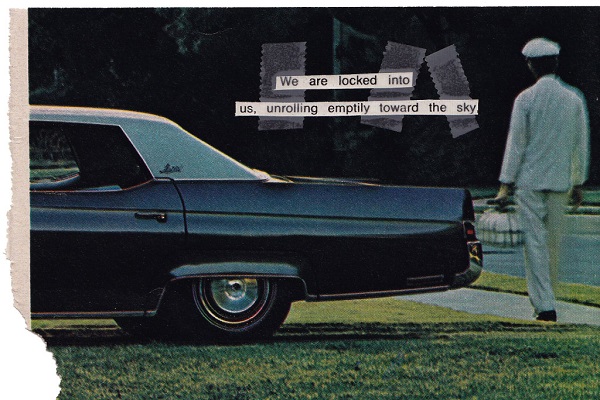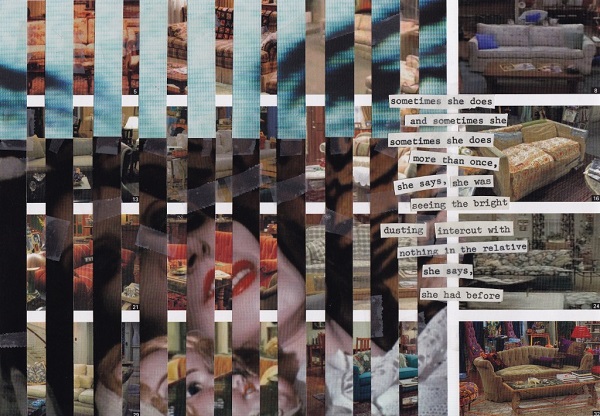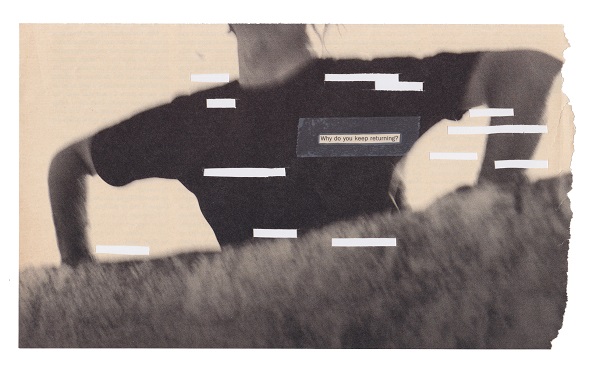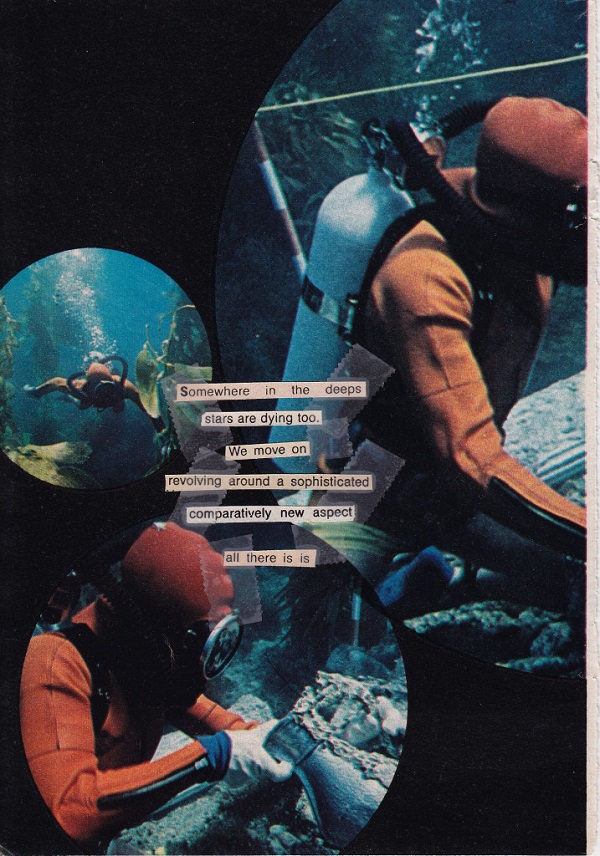Artist-in-Residence Kate Ingold Breathes Life Back Into Damaged Goods
March 23, 2018 11:29 AM
by Naomi Okuyama

We sat down with one of this spring's Camera Obscura Artist-in-Residence Kate Ingold to learn more about her practice. She's not only going to lead free public workshops in collage, but also be onsite at the Camera continuing her work on "Damaged Goods/Small Repairs." Reservations for the workshops can be made via Reserve Santa Monica (account required).
The artwork series showcases repairs and embellishments of discarded handmade quilts, scratched drawings on original photographs, and image/text collages made of vintage and new magazines. Kate Ingold is in residence with artist Brittany Ransom (read Ransom's artist-in-residence interview). Both residencies run April 25 – August 1, 2018. Their final joint show will take place on Saturday July 28 from 3-6pm at the Camera Obscura Art Lab.
We asked Kate about her work, poetry and the idea of chance:
Question: You work in diverse media, from 2D – photography and collage, to 3D – textiles and installation and even 4D – time based, performative and social practice work. Does what you say in your work change with the medium? Are there through-lines?
Kate Ingold: I work in series/projects, with overarching conceptual questions in mind with each project. The media I use are all in service of the overall series/project, so in this way all of the work is intricately linked, regardless of the media I am using. The question of what the work says is perhaps best answered by viewers of the work. Since we all bring our own memories and experiences to our encounters with artwork, I think it’s likely that someone who has a history with quilts and handwork will approach my textile pieces differently than someone who doesn’t. I presume the same is true for my photography-based pieces. Do they say something different to an Instagram user than to someone who doesn’t use social media? I saw a smartphone ad recently that said smartphone users took over 1 trillion digital photographs last year. 1 trillion! We are inundated with images constantly, which is one of the reasons why I often reject the primary advantage of photography, its reproducibility, by treating my printed photographs as substrates for drawings. Does a photograph-turned-drawing say something different than a digital photograph on a screen? I hope so!

Q: “Damaged Goods/Small Repairs” is the name of your residency project at the Camera, and you’ve been working on this series for a while. Can you tell us more about that?
KI: “Damaged Goods/Small Repairs” is a multidisciplinary inquiry into tenderness, disintegration, and repair. I began working explicitly on “Damaged Goods/Small Repairs” about five years ago, though the project had its first beginnings even earlier than that. I started photographing damaged architecture and architectural elements that were under repair — facades covered in scaffolding, bricks held up with netting, windows boarded up with plywood — in 2011. Soon after, I began photographing window displays, particularly the seams and joints of mannequins that were askew or visible damaged, and also started buying work and tattered hand-sewn quilts and quilt fragments on eBay, along with broken and badly-repaired porcelain figurines. It was after I collected these images and objects that I came up with the title for the series.
All of my work of the past fifteen years has been about damage and repair on one level, but “Damaged Goods/Small Repairs” is more directly approaching these twinned ideas. I believe there is beauty in the imperfect and scarred, and that the effort to repair is worthwhile, no matter how futile the effort may be. I am interested in pushing back against the desire to dispose of, throw away, or hide that which makes us uncomfortable or emotionally vulnerable. The language around suffering is difficult, which is why I chose the name “Damaged Goods/Small Repairs” for this series. “Damaged goods” is loaded with judgement, particularly when it is used to talk about women and girls. A question that has continued to come up for me while working on this project is, what does it mean to bring the sacred back to the broken and discarded? I’m also asking questions about sincerity and sentimentality and digging deep into the notion of “nostalgia for the future,” or more specifically, nostalgia for a future that never came to pass. Svetlana Boym wrote a book about nostalgia in post-soviet Russia called The Future of Nostalgia, which first got me thinking about the role of nostalgia in shaping how we see ourselves and our dreams/nightmares. I was in Pacific Palisades recently and there’s an advertisement for a new shopping mall that says, “Be nostalgic for the future,” with images of beautiful, extremely happy and content people holding hands. Interesting that they’ve used the language of pathos and regret (nostalgia is loaded with both, in my experience) to talk about shopping.

Q: What does handwork mean to you in the contemporary context?
KI: I remember about a decade ago when there was this palpable fear that handwork was going to disappear. The allure of the digital seemed too great to resist. But instead there’s been a resurgence of interest in all things handmade (and, of course, the realization that even those digital gadgets were made by human hands). Etsy and other craft-marketplaces attest to this resurgence. I’m compelled to make things with my hands. I like the ritual and repetition of sewing and scratching and carving. This doesn’t mean that I don’t also use digital methods and materials sometimes — I gave up my film camera years ago — but I’m attracted to art that shows the work of the artist and I’m compelled to contribute to that long dialogue between makers. I like to see mistakes and errors and irregularity. If you look deeply enough at an Agnes Martin painting, suddenly the slight imperfections become visible and you see Martin’s hand in the work. I love those moments of discovery and connection.

Q: What is the role of chance in your work?
KI: I recently listened to an On Being podcast with theoretical physicist Brian Greene who argued that choice is a fiction and that the universe preordains everything. I wasn’t convinced (where’s the evidence?) but the conversation did go back to that essential human question of fate vs free will. I’m reading the new translation of the Odyssey right now (the first one written by a woman, Emily Wilson) and you see both right there — Tiresias, the oracle in Hades, tells Odysseus his future could go a couple of different ways depending on what he and his men did. The gods set the parameters — a limited number of possible outcomes — but it was Odysseus’ choices that would decide which outcome would come to pass. The question is, what is ‘chance’ in this? Could there be ‘chance’ in this mythological Greek world when the gods controlled everything, including the winds? In this context is ‘chance’ the same thing as ‘fate?’
"What is chance?" is an interesting philosophical question, especially when it applies to art and art making. Is it when outside forces dominate a process? Is it about randomization, even if that randomizing is systematized? Is chance the same thing as improvisation, or is that more like free will? John Cage engaged in what I’d call controlled chance operations — he set parameters and rules and then worked within them, or I should say, obeyed his own imposed rules regardless of the consequences. I also often assign rules for myself and let the rules dictate where the work goes. In the case of the collages, I decide that I will only use images and text from one specific magazine, for instance, or a select group of magazines. This severely limits my choices and makes the work deliciously challenging to make. With the photographic pieces, it’s another story. Chance comes in only in the photographing itself when I happen upon a scene or situation that makes an interesting photograph. After I print the photograph, I decide on a plan and execute it. The execution can fail and then the piece is ruined. There’s very little room for error. The textile pieces give more space for error and revision. I can begin one way and decide it’s not working and change direction. Certainly with the performative installations I’ve done I have to be open to whatever happens. A lot of the ‘success’ of the work is out of my hands once the performance begins or the installation is made. I did an installation at Bray Grove Farm south of Chicago a few years ago and the humidity and the bunnies and heat all impacted the work. The curator, artist and farmer Joanne Aono, told me that the piece began to reflect the bodies of her and her husband as they worked their organic, equine-powered farm. The piece sagged in the afternoon heat and perked up in the crisp morning air. It brought me incredible joy to know that the piece was responding to the environment in that visible way.

Q: Every week you are offering a collage workshop that is focused specifically on the interaction of words and images. Is the poetry world separate from the art world?
KI: I think in terms of their commercial aspects, poetry and art are very separate. But there are a number of artists who use text in their work and a number of poets who are either also visual artists or collaborate with visual artists. We’re exposed to image/text constantly — advertisements, illustrations, newspapers, even news scrolls on the bottom of CNN. What I’m interested in is bringing image and text together to form a third thing. I might use the language of advertising or the visual tropes of illustration, but I’m trying to make something that would not fit into either of those categories. Ideally, the image and text combine to elicit a response — a profound moment, a funny moment, an absurd moment — that leaves that residue that art can leave. that ineffable something that sticks with you for awhile.
More About Kate
Kate Ingold's work spans textiles made from recycled and new materials to stitched and etched drawings on digital photographs, sculptural, video and performative installation, and image/text collage. She examines issues of disturbance, reparation and collapse, and the nostalgia and regret that can accompany loss. Her chapbook, Dream of Water, was chosen by Harryette Mullen for the Poetry Society of America’s National Chapbook Fellowship and was published in 2008. Kate received her MFA from the School of the Art Institute of Chicago and currently lives in Los Angeles. More at kateingold.com.
About the Camera Obscura Studio Artist Residency Program
Presented by Santa Monica Cultural Affairs at the Camera Obscura Art Lab, the program connects the public with artists and artisans working within and between the worlds of fine art and craft. Artists-in-residence share their work with the public informally and through workshops and master classes. If you're an artist interested in receiving alerts about this program and other opportunities with the City of Santa Monica's Cultural Affairs Division, join the Artist Opportunity email list. See Santa Monica Cultural Affairs Current Calls For Proposals.
#ArtSaMo
Authored By
Naomi Okuyama
Cultural Affairs Supervisor